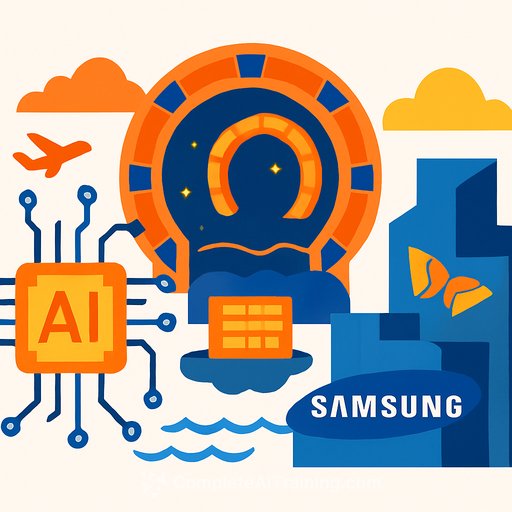OpenAI, Samsung, and SK link up on $500B "Stargate" infrastructure push
OpenAI has partnered with Samsung and SK to supply chips and other technology for Stargate, a long-term plan to expand AI infrastructure. The effort centers on large-scale data centers, memory capacity, and new build-outs that lower cost per token while improving throughput.
The announcements followed meetings in Seoul between OpenAI leadership, senior South Korean officials, and corporate leaders, including Lee Jae-myung. The move is a clear signal: memory supply, cooling, and energy are becoming as strategic as model architecture.
What the deals cover
- Samsung Electronics and SK Hynix will accelerate production of advanced memory and chips for OpenAI's rising memory demands under Stargate.
- OpenAI and SK Telecom will evaluate building an AI data center in South Korea ("Stargate Korea").
- OpenAI and Samsung affiliates (Samsung C&T, Samsung Heavy Industries) will collaborate on data center technologies, including floating data centers to ease land constraints, reduce cooling costs, and cut carbon emissions.
"Korea has all the ingredients to be a global leader in AI - incredible tech talent, world-class infrastructure, strong government support, and a thriving AI ecosystem," said Sam Altman. Samsung Electronics Chairman Lee Jae-yong added that AI requires industry-wide collaboration to chart the path forward.
What Stargate targets
Stargate is a joint venture between OpenAI, SoftBank, and Oracle, with backing from Donald Trump. The companies have committed to invest up to $500 billion over time to build large-scale data centers and secure energy generation to support AI development and delivery.
U.S. build-out status
OpenAI's flagship AI data center in Texas will be joined by five additional U.S. sites: two more complexes in Texas, one in New Mexico, one in Ohio, and another in an undisclosed Midwest location. Expect staged capacity coming online, with procurement and interconnect schedules driving availability windows.
Why this matters for engineering teams
- Memory availability: Expanded supply from Samsung and SK Hynix should improve access to high-performance memory critical for large context windows and fast training/inference. See the HBM standard overview from JEDEC for background: HBM at JEDEC.
- Cost curve: More capacity and better thermals (including water/sea-cooled options) can lower unit costs and stabilize GPU/MEM pricing volatility.
- Latency and data locality: A potential "Stargate Korea" creates options for Asia-Pacific workloads with strict data residency or low-latency needs.
- Energy and cooling: Floating data centers point to higher-density racks and improved PUE via ambient water cooling - useful for high-heat HBM and GPU clusters.
- Network design: Expect higher east-west traffic and tighter fabric requirements; plan for congestion control, QoS, and observability around model serving spikes.
- Capacity planning: Treat new sites as capacity buffers for training queues, RLHF pipelines, and high-throughput batch inference.
Developer and ops implications
- Model ops: Prepare for larger context and memory-heavy inference; validate tokenizer and KV cache strategies against new memory ceilings.
- Data engineering: Co-locate feature stores and vector DBs near target regions to reduce tail latency; revisit replication and failover SLAs.
- Networking: Pre-test multi-region routing, service mesh limits, and observability budgets for cross-DC calls.
- Procurement: Align GPU/memory reservations with expected delivery quarters; evaluate multi-vendor strategies to avoid lock-in.
- Sustainability: Include thermal envelopes and power budgets in cost models; cooling method can materially affect total cost of ownership.
Action steps
- Map workloads to regions (US vs. Korea) by latency, compliance, and data gravity.
- Run capacity forecasts for training and inference separately; reserve ahead for peak seasons.
- Benchmark inference under memory-rich configs; test speculative decoding and paged attention at larger batch sizes.
- Update runbooks for inter-region failover and quota exhaustion events.
- Upskill teams on modern AI infra and ops. See practical paths by role at Complete AI Training: AI courses by job and coding-focused credentials at AI Certification for Coding.
The bottom line
This is a capacity and infrastructure story. More memory, more sites, better cooling, and clearer energy plans mean stronger foundations for training and serving. For IT and development teams, the advantage goes to those who plan procurement, placement, and observability early - and ship with those constraints in mind.
Your membership also unlocks:






